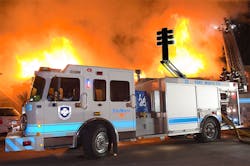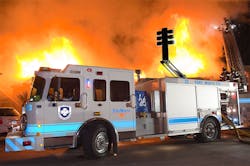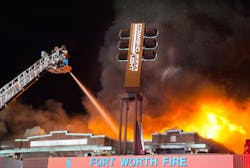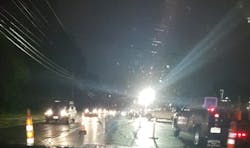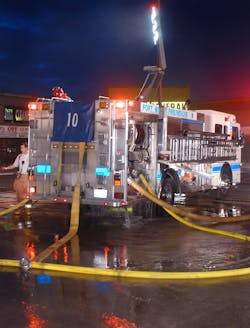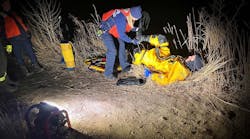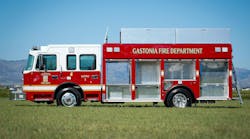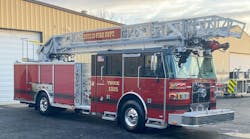Ask any experienced photographer what elements make a great photo and they will tell you very simply, “It’s all about the lighting.” The same answer can apply when operating on emergency scenes of all types. It is important to know where, when and how lights can be placed and used for maximum effectiveness and operational safety for the troops.
Power source
Before discussing light placement, let’s begin with the basics of lighting. It wasn’t long ago when every fire apparatus had generators that were able to supply household conventional 110-volt power for our lighting needs in addition to smoke ejectors and blowers that moved air and/or removed smoke. There are certainly many vehicles with generators today, but much of our emergency lighting is now cordless. This makes our lighting needs more available. There are still many small portable generators that have quartz single-head lighting attached so they can be maneuvered at accident scenes and at the rear of structure fires. Battery-operated lighting, however, is much more convenient and can be placed in remote areas very easily. While battery-operated lighting is becoming more common, there are many legacy power and lighting systems still in use today.
Batteries bring a certain set of challenges with them as well. Vehicles must now have on-board charging systems. The last thing you want to have happen is to rely on battery power and not have your batteries ready when you need them. Please check your manufacturer recommendations so that you know exactly when and how batteries need to be charged and changed for maximum use. Batteries come in all sizes and types and the newest batteries do not “hold a memory” like the previous versions of nickel-cadmium batteries that needed to be cycled repeatedly.
Existing lighting systems consist of halogen and quartz, but today all lighting is now light-emitting diode (LED). The future is LED because of its lower power demand and quality of light output as well as the number of lumens available. LED lighting has allowed us to get better lighting when we are on the scene.
How bright is bright enough?
Modern fire service lighting is generally measured in lumens. There are three terms we need to understand when we talk about the measurement of light. Candlepower is the light that illuminates a 1-square-foot area, 1 foot away from a candle. One candlepower is equal to 12.57 lumens. Departments should generally try to get as much light as possible from a battery source. More lumens are generally considered better, but as you increase the intensity of adjustable lighting, your battery run time will almost certainly be reduced. There are many lights that will take large amounts of lumens, but often do not reference the limited run time at the highest settings.
When purchasing emergency scene lighting solutions, pay close attention to the quality and quantity of light based upon battery run time. This discussion also leads us to try and purchase lighting that has various adjustments for light intensity. There are so many variables here so be sure to check the manufacturer’s individual recommendations.
Types of lighting
Generally, there are two descriptions of light: spot lighting or flood lighting. Both are determined by the “throw” of the light, which measures how far the light will travel from its source. Flood consists of the width of an angle at which light can be visible. This is generally a wide pattern that doesn’t go far from the source in distance but covers a wide area of light in which to operate. Spot lighting throws a beam a great distance and is a great choice for searching, marine rescue and high-angle rescue. Flood lighting is perfect for large area scene lighting.
Lighting also has two purposes—for people to see you and for you to see things, including your working area. Lighting variables are really based upon the types of incident. Let’s take them in some brief logical order:
1. Vehicle accidentsWhen operating on roadway incidents, lighting is critical both in quality of light and placement. Obviously, all lighting should be facing forward so as not to blind the oncoming traffic. One of the vehicle-mounted solutions which should be employed whenever possible is the “brow light.” This light, mounted right above the windshield, allows a flood pattern of light to be thrown on the scene and allows the vehicle to be set for blocking and protecting our personnel. This on-vehicle lighting may also be supplemented by additional portable lighting. All apparatus emergency lights should be operating and if there is a directional arrow stick in the rear, it should be set to force traffic in the direction you choose. There are conflicting opinions on this and there is some research now that indicates that emergency warning lights be shut down while crews just use the arrow stick lighting. People drive all day on roadways through construction sites and follow an arrow, but they may be distracted by flashing red and blue lights. There have been many cases where accidents have occurred due to drivers being blinded by warning lights. If you are in an opposite lane, you may want to shut high beams off.
The other scene lighting option that is superior in these cases is an articulated vehicle-mounted command light tower with four to six heads mounted on it. These lights are generally generator powered as they demand a larger supply of power. These vehicle-mounted lights can be raised, lowered and adjusted usually by a corded remote control. These lights can be used easily at vehicle and roadway scenes. We will also discuss their use at structural fires as well.
When vehicle accidents occur, there are now strobe LED markers that can either be used as standalone devices or inside and in conjunction with standard traffic cones. When using illuminated traffic markers such as these, make sure you place them at an adequate distance to the rear corresponding to the speed of the roadway traffic. Most fire departments today make the roadway hazard zone too small by placing a few cones very close to the working apparatus.
2. Structural fires
Lighting is essential at all structural fires. If you have a vehicle-mounted command light I suggest that you have the pump operator turn it toward the building and flood the face of the building. I also suggest that the light be angled downward so that is does not blind members walking out of the building. In addition, it should also be able to be viewed from the inside, through any window or door opening. The pump operator should always get water first, but lighting is generally considered a task in most departments that can be easily accomplished by the chauffeur.
Portable lighting should be placed on all sides, but if that is not possible, light all corners of the building so that there are absolutely no dark areas.
I am a big proponent of placing lighting at the primary point of entry that crews use. This is a double-edged sword because you want the light at the opening to be seen from the inside but if a tripod is used, it needs to be placed far enough back so it does not interfere with the hose stretch. These lights should also be angled downward so as not to directly blind members.
At structural fires even the rear hosebed loading spotlights can be directed into windows on upper floors to help orient interior crews.
While the focus is on lighting the building, consideration should be given to lighting the ground area, and/or the operating area where members will be. I can think of specific cases in my career where during nighttime operations, members have fallen and/or tripped on well openings, koi decorative garden ponds, swimming pools and other hazards.
Portable lighting or tower ladders can put lighting on the roof area for enhancing nighttime roof work. In urban areas, lighting can be set up on rooftops of adjacent buildings. When using rooftop lighting, again, angle lights downward to avoid causing bright spots that can temporarily blind members working on the roof.
3. Command posts, rehab and fire investigation
Adequate lighting should be available for any active command post whether a vehicle, tent or other location. That lighting might also be used to adequately light an area for a press conference, too. Adequately lighting the command work area is useful for accountability, command worksheets, reviewing maps and charts, and photos that all might be relevant to the decision-making process.
Rehab areas often use medical ambulances. Additional lighting, however, should be provided for the assessment, rehydration and resting locations. Not only is the lighting essential for the care of our members, but also for the writing of reports and to some degree, a boost in mental well-being.
Fire investigations for cause and origin are probably some of the darkest conditions we work in, other than initial fire attack. Most members with handheld lights are out of the building. In the past, most work was often done using handheld lights and flashlights because that was all they had. In order to be effective as an investigative team, tripod battery-operated lighting should be brought in. The ability to do the investigative work—and the ability to photograph properly—is enhanced by good lighting. In addition, since this is the last stages of the fire, hazards such as holes in the floor and falling debris can easily be seen and avoided with proper lighting.
If a safety hazard develops on the fireground, one of the first courses of action might be to assign a senior chief, secure a collapse zone and increase the lighting.
Shine a light on an important asset
Lighting is sometimes overlooked because of the lack of manpower, but adequate and safe lighting can enhance operations at fires, on roadways and at other operations. When it comes to scene lighting:
- Consider setting up lighting early in the incident even if it is not dark yet
- Understand what type of lighting you need: flood or spot
- If you are using power cables and generators, ensure good cords and GFI protection is in use
- Have multiple adapters for electrical cords (mutual aid and building outlets)
- When setting up scene lighting, avoid and eliminate shadows
- If using battery-operated lights, make sure batteries are charged and maintained
- When using tripod stand-mounted lights, consider anchoring or weighting the base
- When operating on scene, maximize the options with your emergency vehicle warning lights, your rear-facing arrow sticks and use of high-intensity strobes
- If you are marking a roadway safety zone, start back farther than you think
Other than responding with our emergency warning lights, most fire departments take working scene lighting for granted. Proper lighting can be extremely helpful, and you should train with your mutual aid partners to see if they have compatible equipment.
